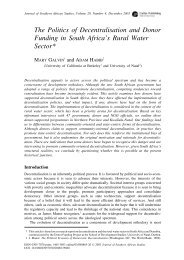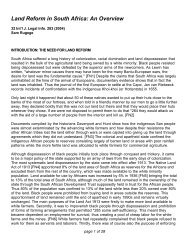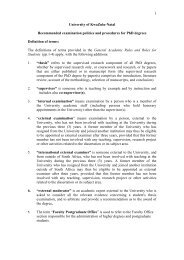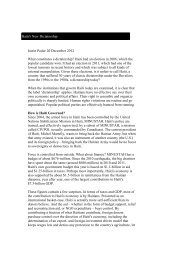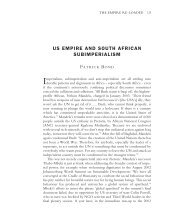Bell, Trevor : Unemployment in South Africa
Bell, Trevor : Unemployment in South Africa
Bell, Trevor : Unemployment in South Africa
Create successful ePaper yourself
Turn your PDF publications into a flip-book with our unique Google optimized e-Paper software.
autonomous and largely <strong>in</strong>dependent of changes <strong>in</strong> relative factor<br />
prices1 )<br />
To see why slow growth and low real <strong>in</strong>terest rates have been<br />
associated, it is important to consider why real <strong>in</strong>terest ratee have<br />
become negative <strong>in</strong> the first place and turned dam sharply after<br />
1973. Some take it that the real <strong>in</strong>terest rate fell simply because<br />
the rate of <strong>in</strong>flation rose rose sharply. However, it is arguable<br />
that real <strong>in</strong>terest rates fell, right round the world, due largely to<br />
an autonomous fall <strong>in</strong> the profitability <strong>in</strong>vestment and hence <strong>in</strong> the<br />
demand for <strong>in</strong>vestment funds; and this decl<strong>in</strong>e <strong>in</strong> profitability was<br />
largely connected with ris<strong>in</strong>g primary product prices, relative to<br />
manufactures <strong>in</strong> the late 1960s. and from 1973 on especially with<br />
ris<strong>in</strong>g energy prices2). This would clearly have reduced the use<br />
of energy, but also, by reduc<strong>in</strong>g the marg<strong>in</strong>al productivity of other<br />
<strong>in</strong>puts, the demand for capital and labour as well. Thus rather than<br />
slow employment growth be<strong>in</strong>g caused by high <strong>in</strong>flation rates and low<br />
real <strong>in</strong>terest rates, these are likely to have been the consequence,<br />
together with slow economic growth, of a number of exogenous shocks<br />
such as the massive <strong>in</strong>creases <strong>in</strong> energy prices. This explanation of<br />
the fall <strong>in</strong> real <strong>in</strong>terest rates suggests that even if the decl<strong>in</strong>e <strong>in</strong><br />
<strong>in</strong>terest rates did contribute <strong>in</strong> some measure to the ris<strong>in</strong>g rate of<br />
growth of K h there was little the authorities would have been able<br />
to do to prevent them from fall<strong>in</strong>g.<br />
iii) The upshot of our argument ia aections (i) and (ii) is that the<br />
predom<strong>in</strong>ant cause of ris<strong>in</strong>g Black and non-Black unemployment rates<br />
has been a decl<strong>in</strong>e <strong>in</strong> the rate of growth of the demand for labour and<br />
that this has been due primarily to a fall <strong>in</strong> the rate of economic<br />
1) In some measure, too, it is possible that regional policy, especially<br />
direct controls on the use of Black labour <strong>in</strong> terns of Section 3 of<br />
the Physical Plann<strong>in</strong>g Act may be responsible for the <strong>in</strong>creas<strong>in</strong>g rate<br />
of growth of the K/L ratio.<br />
2) See Wilcox (1983).




